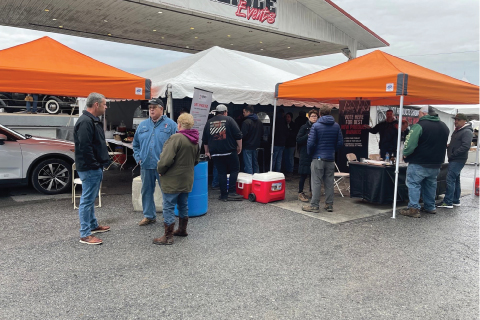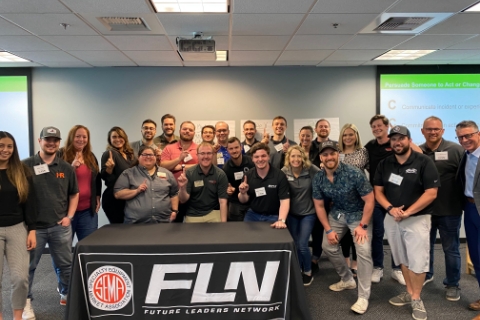SEMA Member News—March 2020
By Ellen McKoy
 Ron Alexander is associate professor of automotive technology at SUNY Morrisville, which offers two- and four-year automotive degree programs. Ron Alexander is associate professor of automotive technology at SUNY Morrisville, which offers two- and four-year automotive degree programs. |
SEMA Student Programs Pave a Pathway to Aftermarket Careers
Activating the next-generation talent pool is a hot topic. To help inspire future influencers and innovators, SEMA offers resources designed to engage students and provide a pathway to careers in the automotive aftermarket.
The best-known program is the SEMA Memorial Scholarship Fund. Since its founding in 1984, the fund has awarded more than $2.5 million to 1,500-plus college students. Last year alone, SEMA awarded $272,000 to 97 individuals.
Over the years, SEMA has forged relationships with trade schools, colleges and universities known for their automotive-related curriculum through the scholarship program and other outreach efforts. Often, scholarship recipients have the opportunity to visit the SEMA Show.
Attending the Show for the first time is an eye-opening experience—a chance for students to talk to exhibitors, hand out résumés and be amazed by the scope of the specialty-equipment market. They also get to participate in the SEMA Student Program.
Career Day is an integral part of the Student Program. It gives participating exhibitors the chance to connect with bright, young prospects who potentially represent a future workforce. Last year’s event included more than 40 companies and was attended by more than 700 students and faculty.
For insights into how the SEMA programs benefit the students, SEMA Member News reached out to Ron Alexander, associate professor of automotive technology at SUNY Morrisville, and Dr. Jeff Jarvis, president of the University of Northwestern Ohio.
Optimizing Opportunities
 Dr. Jeff Jarvis, president of the University of Northwestern Ohio, has been involved in SEMA education programs for nearly three decades. Dr. Jeff Jarvis, president of the University of Northwestern Ohio, has been involved in SEMA education programs for nearly three decades. |
SUNY Morrisville, part of the State University of New York, is located in rural Madison County. Established in 1908, the college offers more than 80 associate and bachelor’s degree programs as diverse as agriculture, business, social sciences, liberal arts and automotive technology. Automotive areas of study run the gamut.
“We have two- and four-year degree programs,” said Alexander, whose technology department is headed by Associate Professor Ray Grabowski. “We have an advanced-level bachelor’s in technology and a two-year associate’s degree option. The four-year option prepares students to work for OEMs and the aftermarket in research and development. Then there’s a bachelor of business administration degree in automotive management, two-year mechanic courses in automotive technology, and an associate’s degree in auto body.”
Students can also join the school’s automotive club, which hosts car shows and participates in the SEMA Show.
“Through our relationship with SEMA more than 10 years, we’ve brought third- and fourth-year students to the Show as part of the SEMA Student Program,” Alexander said. “It started out as an auto-club field trip, but it’s actually grown into curriculum.”
The for-credit elective is a basic introduction to the aftermarket.
“It’s a special-projects class,” he noted. “Of all the schools that attend the Student Program, we’re the only school that grants college credit for that experience.”
At the Show, students dress to impress—no T-shirts allowed. They visit the New Products Showcase, attend seminars, the new-products awards breakfast and the Young Executives Network reception. They interact with exhibitors and hand out résumés or business cards. At the end of each day, they share their experiences.
“We want the students to understand that this is a networking event, not just a car show, and it’s led to connections over the years,” Alexander said.
Those connections have led to plum jobs or internship opportunities. In one heartwarming example, Alexander recalled meeting a Morrisville graduate at the Show who was working the HMS Motorsport booth—a job he had landed through a prior Student Program connection. He also noted that MOPAR has hired graduates as eastern district managers—an opportunity that arose after MOPAR learned that there’s an East Coast college that offers four-year automotive degrees.
“Once that MOPAR connection was made, it’s been both an internship and a direct-hire opportunity,” Alexander said. “We’ve also made successful connections at Snap-On, Delphi, Borg Warner and others. All of those relationships were created through the SEMA Show.
“The Show has opened our eyes. As we start to develop courses and curriculum, it has broadened our perspective about the aftermarket industry, and it has opened doors to career opportunities for our students. The SEMA Student Program is of real value to both our students and our school.”
Tapping the Talent Pipeline
The University of Northwestern Ohio (UNOH) has a long-standing relationship with SEMA. Founded in 1920 in Lima, Ohio, UNOH is widely known for its automotive curriculum—especially its focus on performance and motorsports. Over the years, many students have earned SEMA scholarships or loan-forgiveness awards, including 12 awardees in 2019. A significant number of graduates have gone on to careers in the aftermarket industry.
“I’ve been personally involved with the SEMA education and the scholarship program for 27 years,” noted Jarvis, who at one time served on the SEMA Scholarship Committee. “I went back as far as I could in my records, and we’ve had over 120 scholarship winners through the years. We bring only scholarship winners to the Show and its education portion. I was surprised to see that about 35% of the scholarship winners have gone on to work directly for SEMA-member companies.”
UNOH consists of five colleges that offer 50 different majors and degree programs, including for business administration, marketing, accounting and, of course, automotive. Besides a bachelor’s degree in automotive management, there are more than a dozen automotive-related associate’s degree and diploma programs.
“One of our colleges is the College of Applied Technology, where we teach automotive diesel, high performance, robotics, alternate fuels and other programs,” Jarvis said. “We also have a sports marketing program as well as degrees in marketing and accounting—things that are not performance-based.”
Jarvis estimated that 20% of UNOH scholarship awardees now work for SEMA-member companies in marketing, sales or management.
“There are opportunities in the industry for those students, but most of the scholarship winners we’ve brought to the SEMA Show through the years have had the technical, hands-on experience,” he said.
In reflecting on the relationship between SEMA and UNOH, Jarvis credited an early-’90s meeting with former SEMA President Chuck Blum and Hall of Famer Harry Hibbler with helping to create a blueprint for the school’s motorsports program.
“Chuck, Harry and I sat down after a SEMA management conference in Phoenix and scratched out our high-performance program on a napkin,” Jarvis recalled. “I brought it back to our faculty, and we came out with the first-ever high-performance motorsports program in 1993. So SEMA and UNOH are intertwined, and in my opinion, it’s a fantastic relationship.”
Jarvis said that the Student Program at the Show that SEMA Manager of Student Programs Juliet Marshall oversees is an important part of the relationship, especially for students who are close to graduating and who get job offers in their chosen career paths.
“It’s a tribute to the industry and to SEMA for their tremendous support of the scholarship program,” Jarvis said. “It’s a home run for the young people. We love SEMA, and we love the SEMA-member companies for what they do to hire our graduates.”








